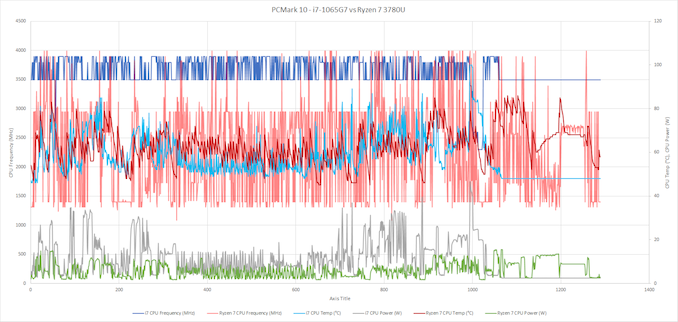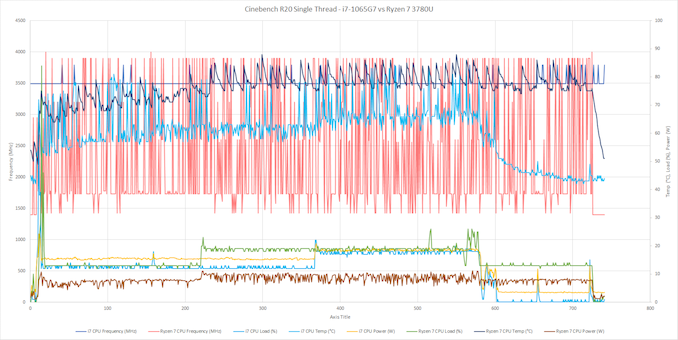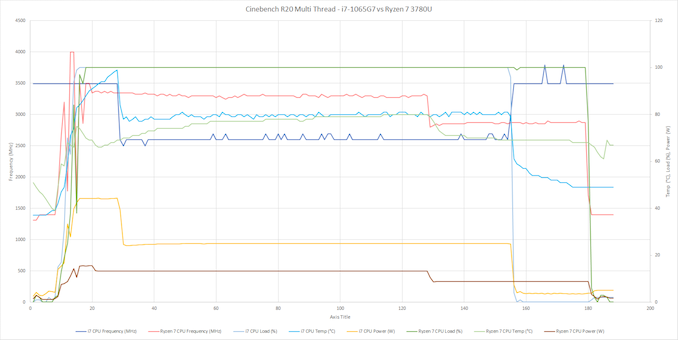The Microsoft Surface Laptop 3 Showdown: AMD's Ryzen Picasso vs. Intel's Ice Lake
by Brett Howse & Andrei Frumusanu on December 13, 2019 8:30 AM ESTBenchmark Analysis: Boost Behavior
Let’s dig into some of the testing to see how the systems responded during the benchmarks. We re-ran several of the tests while simultaneously monitoring the processor frequency, temperature, and power. Unfortunately for our comparison, the power polling results provided by our monitoring tools don’t seem to monitor the same power draw. The Intel power numbers are for the SoC package, but the AMD power numbers appear to be just the CPU cores, which is an unfortunate byproduct of testing two different platforms.
PCMark 10
PCMark 10 is a benchmark platform that attempts to simulate real-world tasks by running a variety of workflow, and the results were perhaps the most interesting of any of the benchmarks. There is a major discrepancy in how the AMD CPU behaved compared to the Intel. The Ice Lake platform kept the CPU frequency at a minimum of 3.5 GHz, with bursts to 3.9 GHz when under load. The Picasso processor was very aggressively switching from low frequency to high frequency, and was rarely indicating that it was over 3.0 GHz, but clearly demonstrating its higher peak frequency of 4.0 GHz in several locations. Both systems were fairly even in terms of CPU temperature, and Intel’s aggressive turbo levels were evident with peak power levels of 40 Watts for brief moments. The Ice Lake platform finished the benchmark about 200 seconds quicker than the Picasso system.
Cinebench R20 Single-Thread
We see somewhat similar results when only a single CPU core is loaded with the Picasso CPU frequency varying quite a bit. There’s also an average higher temperature on the AMD platform during this workload, and once again Ice Lake finishes the rendering quite a bit sooner thanks to its stronger CPU cores.
Cinebench R20 Multi-Thread
With all cores loaded the graph is considerably altered. Here the AMD processor is able to maintain a much higher frequency across its cores for much longer, while Intel's chip is only able to maintain 3.5 GHz for about 30 seconds before it runs out of headroom, dropping the cores down to around 2.6 GHz. But despite the lower frequency, the much higher IPC on Sunny Cove allows the Ice Lake platform to finish quite a bit sooner.













174 Comments
View All Comments
Zoolook - Saturday, December 21, 2019 - link
@RSAUser I think you nailed it, it's better for their bottom line to dedicate 7nm chips to products with higher margins.shabby - Friday, December 13, 2019 - link
What is amd waiting for with zen 2 for mobile? Are they prioritizing desktop and server chips first or is there a lack of capacity at tsmc with everyone hogging the 7nm process?RBD117 - Friday, December 13, 2019 - link
I think it's a mix of everything. Renoir is being worked on actively but AMD doesnt have enough resources to do all of Ryzen AM4, EPYC, and Ryzen Mobile at the same time. The desktop and server chips were prioritized first as those have clear wins over Intel solutions. Mobile however requires a lot more work with battery life and performance optimization. And yeah, we already see chip production issues with Ryzen 16 and 12-core as it is with most of the chips going to EPYC so Zen2 mobile would just add more capacity issues.Targon - Friday, December 13, 2019 - link
AMD should be releasing the Zen2 laptop chips at or around CES 2020(in another three weeks). Microsoft was probably preparing the Surface Laptop a good five months ago so AMD just didn't have samples ready for Microsoft at that time.sing_electric - Friday, December 13, 2019 - link
Realistically, TSMC's 7nm process (used in Zen 2's compute chiplets) is expensive and capacity-constrained. AMD gets around this on desktop by creating a separate IO die on an older, cheaper process, but that doesn't scale well to mobile.To get Zen 2 on mobile, they'd likely need everything - compute, IO and GPU - to be on 7nm, and the chip would be considerably larger than (desktop) Zen 2's compute chiplet.
AMD basically had a choice - for a given number of 7nm wafers, they could get a few mobile APUs or a lot more desktop CPUs (and GPUs for their 7nm options). The margins are much better doing the latter, so that's what they did.
There's also the fact that we don't know what their agreement is with Global Foundries on 14/12nm wafers - we do know that AMD's agreement with them didn't require GloFo to finish its 7nm process. AMD has a commitment to buy some number of wafers from GloFo per year for a certain length of time, and it's likely that is a factor as well.
lmcd - Friday, December 13, 2019 - link
Disagreed -- cheaper IO dies have worked on mobile for years. The "cheaper" process is literally the process Zen+ shipped with.Problem is entirely integration -- now that Navi (a major release) has shipped, AMD can integrate the current version into chiplet form, then port those integrations to the incremented version of Navi ready to ship next year. Since the chiplets provide a substantial level of decoupling, incremental upgrades should be reasonably easy to integrate.
RSAUser - Friday, December 13, 2019 - link
Doubt the I/O die size matters in this case, doesn't scale down well so not an issue.Most likely a supply issue and getting Navi to integrate.
scineram - Monday, December 16, 2019 - link
What Navi?AnGe85 - Friday, December 13, 2019 - link
AMD is a smaller company with fewer resources, as you can see with various things. The step by step Navi Launch (currently only Navi 14 is additionally available), delayed 3950X launch, the fragmented Threadripper launch, not until early 2020 Renoir with Zen2, but only combined with Vega (not Navi) and there's still the question when desktop APUs will hit the market.The new suface models presumably have been in development for about a year or even longer. There was no mobile Zen2 in sight ... and this also applies to Apple's Mac Pro and stupid demands like "it should have been Threadripper, not Xeon W". There was no appealing Threadripper available (the old 2000 series still has various flaws and limits and the Mac Pro is an even more complex platform).
Additionally at this point, I would assume, that Microsofts strategy (with the two AMD and ARM models) is more about keeping Intel in check according to pricing and cooperation.
The ARM Pro X has obvious limits and Microsoft also knew about AMDs comparability in advance. Additionally you can assume, that there is a good reason for Microsoft to offer channel consumers to the AMD 15" model (and to limit the Ice Lake model to business users), most likely, because they have to sell x K SKUs to make this experiment (or this Intel pressurizing model?) worthwhile. Maybe with next surface updates in 2021 AMD will be more competitive.
5080 - Friday, December 13, 2019 - link
Margins. EPYC, Threadripper have a much higher margin than mobile APU's.